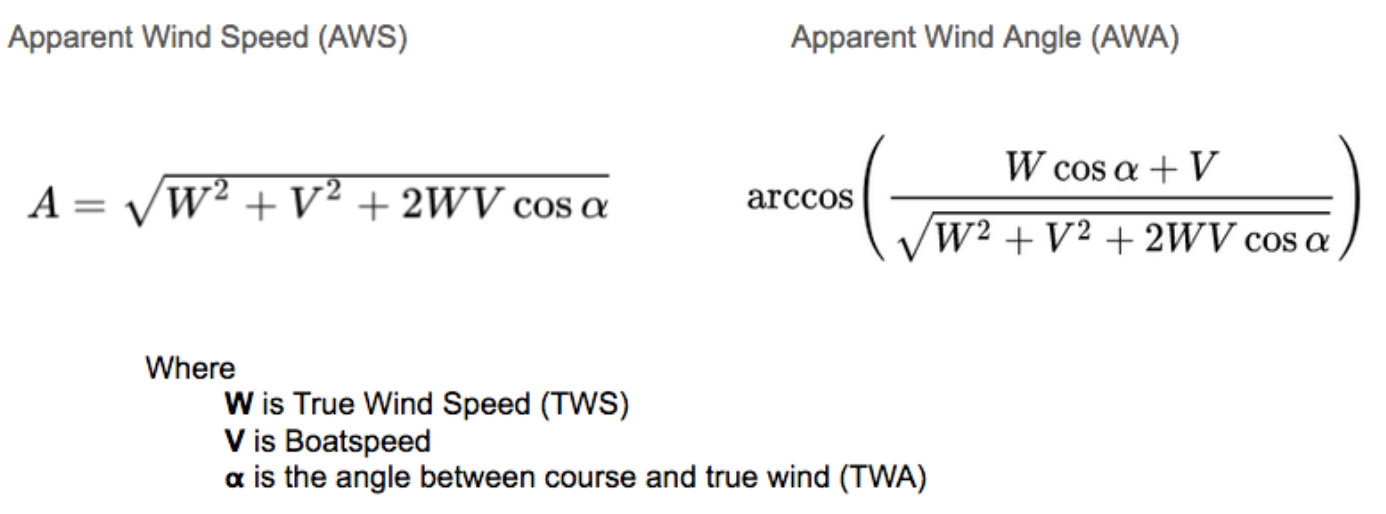Sailing fast - TWA and TWS
First things first: what is the difference between true and apparent wind? The fact is that true wind is measured, and apparent wind is calculated. We sailors use apparent wind most of the time.
Let’s look at an example. Say the current wind is measured at 10km per hour. If you ride your bicycle at 10km per hour directly into this wind, it feels like the wind is 20km per hour (10+10=20). It is the accumulative wind speed and the speed you do on your bicycle. Conversely, if you turn around and have the 10km per hour wind directly in your back, there seems to be no wind (10-10=0). If there is anything in between these two angles, we need to calculator it as follows:

In any case, let’s examine some of these angles and how to use them to sail faster.
TWA (True Wind Angle) and TWS (True Wind Speed) are critical parameters for understanding wind conditions and optimising sailing performance. They also form the foundation of polar diagrams—read more on this.
Here’s what they mean and how they differ:

True Wind Angle (TWA)
- Definition: TWA is the angle between the direction the boat is travelling and the direction from which the true wind is coming. It is measured in degrees.
- Reference: Always relative to the boat’s heading (not the compass or a fixed direction).
- Range:
- 0°: Sailing directly into the wind (impossible for most sailboats).
- 90°: Sailing with the wind coming directly from the side (beam reach).
- 180°: Sailing directly away from the wind (dead downwind).
Practical Use:
- Determines the boat’s point of sail (e.g., close-hauled, beam reach, broad reach, run).
- Used to choose the optimal sail configuration for given conditions.
True Wind Speed (TWS)
- Definition: TWS is the actual speed of the wind as it would be experienced if the boat were stationary in the water.
- Reference: Independent of the boat’s motion (as opposed to Apparent Wind Speed, AWS, which accounts for the boat’s speed).
- Units: Typically measured in knots.
Practical Use: It helps decide the sail trim and the type of sail to use.
- Critical for safety, as it informs decisions about reefing sails in high winds or deploying lighter sails in light winds.
TWA vs. TWS in Performance
- TWA (True Wind Angle): This measure focuses on the direction of the wind relative to the boat’s heading.
- TWS (True Wind Speed): Focuses on the intensity of the wind.
Example in Polar Diagrams:
- A polar diagram plots boat speed at different TWAs for various TWS values.
- For instance, at a TWS of 10 knots, the polar might show the boat achieves maximum speed at a TWA of 45° upwind and 135° downwind.
- Read more about polar diagrams.
By combining TWA and TWS, sailors make informed decisions to optimise speed, efficiency, and safety.

NAVIGATION RULES CLINIC + BASIC SAIL TRIM COURSE
Author
-

Rene is a keelboat instructor and sailing coach in the Mandurah area WA. He is also the author of several books about sailing including "The Book of Maritime Idioms" and "Renaming your boat".
View all posts


